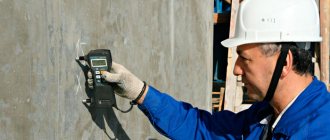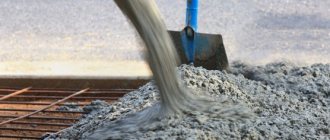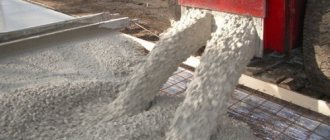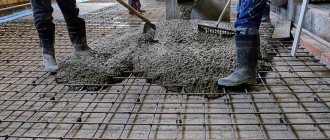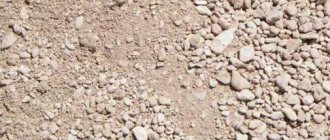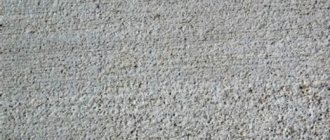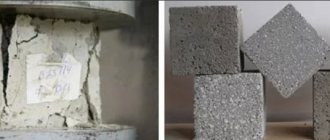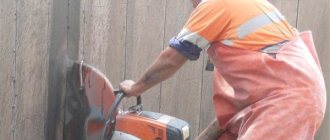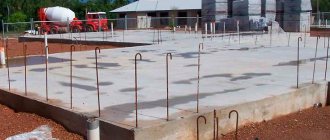Not long ago we wrote about which grades of concrete are advisable to choose when manufacturing certain structures and carrying out various types of work. In this material we decided to cover the topic in more detail. After collecting the most frequently asked questions regarding concrete, we asked experts in the field for comment. In order to cover the topic more broadly, questions were asked to two specialists.
The first expert was Candidate of Technical Sciences Natalya Sergeevna Protko, in the recent past - head of the department of concrete and mortar technology at BelNIIS, today - leading researcher at the Institute of Housing - NIPTIS named after. Atayeva S.S. Natalya Sergeevna has been working directly with concrete for more than 35 years. She has a lot of research work and implemented projects to develop special compounds.
Protko Natalya Sergeevna
Elena Valerievna Novik, a process engineer at a private company, also agreed to answer our questions. She underwent practical training from leading specialists of the city of Minsk (OJSC Minskzhelezobeton, OJSC Stroykompleks, IOOO Tsentrobeton), attended numerous training seminars in the CIS and Europe related to technologies for the production of ready-made mixtures and chemical additives. He has been working in concrete production for more than 9 years. Her expert opinion also interested us because Elena Valerievna communicates directly with customers (both large and individual developers) and can talk not only about concrete, but also about the problems that consumers face.
Novik Elena Valerievna
For the convenience of readers, the information is presented in question-answer form.
What should you pay attention to when choosing concrete?
Novik E.V .:
For large developers - on delivery logistics, unloading time (no downtime for concrete mixers during unloading), laying time. In general, there is such an average norm: delivered concrete must be laid in 1 hour; it is during this time that its mobility characteristics are maintained. Then the solution slowly begins to “set.”
It is also worth paying attention to the composition of the concrete and its scope of application: is it “pure” pouring or is it used in structures with a large amount of reinforcement (can affect the volume), etc.
Well, and the weather. Humidity, air temperature - all this affects the properties of the solution. At temperatures above 25 degrees, concrete loses its mobility much faster.
Individuals should pay attention to the class (grade) of concrete. As a rule, now individual developers choose a material with a margin of strength - after all, they are building for themselves and for a long time. The timing of laying the prepared concrete is no less important - calculate your strength correctly and do everything promptly.
It is also important to pay attention to the date of manufacture of cement, its regulated lifespan while maintaining its “passport” properties is 60 days, after which it may be necessary to increase the amount of cement, since it loses its basic qualities. As for the rest, the choice is entirely up to the buyer.
Protko N. S .:
Concrete must be ordered according to its physical and mechanical characteristics in accordance with the project and, additionally, taking into account the provision of the required characteristics of the concrete mixture at the construction site. To do this, choose a concrete unit located closer to the construction site and negotiate with the manufacturer the required mobility stability of the concrete mixture. In order not to be mistaken in assigning the required shelf life of the concrete mixture, it is advisable when ordering to get acquainted with the possible options recommended by STB 1035.
If necessary, you can negotiate with the manufacturer of the concrete mixture the possibility of restoring its mobility at the site by adding a plasticizer with 1.5–2.0 l/m3 of water to the concrete mixer truck. The proportions of plasticizer depend on the specific chemical additives used in the concrete.
In private (individual) construction, you should pay attention to:
– date of release of cement: the fresher it is, the better;
– storage of cement after purchase.
Cement should be stored in covered, dry areas. If humidity increases, the cement will hydrate, its strength will decrease, and the cement will clump. It is important to pay attention to the integrity and quality of the packaging. For longer storage, each bag should be packed in a plastic bag and tied tightly.
General view of a typical RBU - mortar-concrete unit. This is where concrete is produced. White towers are silos for storing cement.
Classification
Concrete is a composite material containing several main components in its structure - sand, water, aggregate (crushed stone, gravel) and cement. It is the quality of cement and its percentage ratio to other components that determines the brand.
In some construction textbooks, concrete is divided into classes. In order to understand the relationship between brand and class, we provide definitions of these two terms and show a table of relationships.
The digital value of the mark shows the maximum vertical pressure that the prototype (size: 15*15*15 cm) can withstand after reaching maximum strength. The force value in this case is expressed in kg/cm2.
The class of concrete has a similar definition, with the only difference being that the force acting on the prototype is expressed in this case in MPa.
| Concrete strength class | The closest concrete grade in terms of strength |
| B3.5 | M50 |
| B5 | M75 |
| B7.5 | M100 |
| B10 | M150 |
| B12.5 | M150 |
| B15 | M200 |
| B20 | M250 |
| B22.5 | M300 |
| B25 | M350 |
| B27.5 | M350 |
| B30 | M400 |
| B35 | M450 |
| B40 | M550 |
| B45 | M600 |
| B50 | M700 |
| B55 | M750 |
| B60 | M800 |
| B65 | M900 |
| B70 | M900 |
| B75 | M1000 |
| B80 | M1000 |
After getting acquainted with both terms, you can easily conclude that the main property of a concrete mixture is its strength. The higher the digital indicator of the brand, the greater the value of this characteristic. When calculating the foundation and determining the marking, it is necessary to place the main emphasis on the amount of load that will affect the support of the building during the entire period of operation. During the calculation process, it is advisable to multiply the resulting value by a safety factor equal to 1.1-1.2. This will help take into account unexpected loads, such as excess pressure from snow.
Despite the importance of the characteristic, the load value is not the only indicator in choosing markings. When answering the question - what brand of concrete to use for the foundation, it is necessary to take into account the type of soil, freezing depth and groundwater level. A detailed examination of each of the main brands used in construction will help clarify this technical issue. After all, the brand of concrete that is suitable for building a bathhouse foundation will not be the best solution for constructing more loaded structures.
M100. A material with this strength indicator is classified as a light variety. This brand of concrete is not recommended for use for the foundation of a one-story house and other critical structures. This subspecies is characterized by a low cement content, which results in low strength and significant low cost. It is often used as a lower underlying layer (its thickness is usually about 50-150 mm) for the main foundation of higher grades. Due to its efficiency, M100 will be an ideal option for the construction of non-permanent structures - fences, bathhouses, blind areas.
M150. Concrete of this brand is needed as a foundation for a garage. It is also acceptable to use this material in the construction of more critical structures (small one-story buildings), but in this case the concrete support must have a solid foundation in the form of rocky soil. Contact with groundwater significantly reduces the service life of an M150 foundation. In this case, before construction it is necessary to either increase the grade or carry out waterproofing work.
The fear of moisture is due to the low density value that characterizes such brands. Water entering the body of a concrete base destroys its structure, reducing its ability to withstand design loads.
The density of a concrete mixture can be increased without increasing the amount of cement. To do this, the material, immediately after laying in the formwork, must be processed with a vibrator. Vibrations lead to a decrease in air pores in the body of a still liquid substance and thereby lead to an increase in density.
M200. A base with such markings will serve as a reliable support for a one-story building. The percentage of cement in this case is of sufficient importance for acceptable indicators of the strength of the foundation as a whole. But, in this case, you also have to take into account the type of soil and the groundwater level, which should not rise above the freezing mark.
M250. This brand of concrete will serve as an ideal solution for the production of the foundation of a two-story house. In this case, the soil should not have a heaving structure. Suitable species are sandy and rocky. The increased density allows for the presence of groundwater at the same level as the concrete base, but still, as an additional measure, it would not be superfluous to install waterproofing.
M350. Like the previous subtype, it is permissible for the construction of houses up to five floors high, with the only difference that the soil foundation in the case of using this type of concrete may be unstable. The high strength index of M350 compensates for the disadvantage of a weak foundation and allows it not to affect the lifespan of the building.
Strength of concrete. What indicators does it depend on?
Novik E.V .:
To achieve the design (calculated) strength of concrete, it is necessary:
– thorough preparation of the installation site (soil examination, groundwater drainage, high-quality waterproofing before and after pouring, if work is carried out in the cold season - warming up);
– high-quality cement (about 70% of the strength of concrete is provided by cement);
– correct water-cement ratio. Excessive amounts of water are unacceptable, therefore it is desirable to use plasticizers, which allows you to “remove” about 15–20% of “excess” water from the finished mixture. Thus, by adding a plasticizer, the amount of cement can be proportionally reduced, which will ultimately have a positive effect on the overall cost of the concrete mixture.
Protko N. S .:
The strength of concrete in a structure depends on:
– correctly selected composition, taking into account the properties of the materials used;
– conditions of transportation to the installation site;
– concreting technologies;
– compaction conditions;
– compliance with moisture care of the material during the period of its intensive hardening.
Let us consider in more detail the requirements for the composition of concrete. The main factors influencing its strength include: the strength characteristics of cement (grade or class of compressive strength of cement) and the water-cement ratio of concrete (the ratio in concrete between cement and water, including that contained in wet sand).
The strength of concrete is also influenced by the characteristics of the aggregates. For example, if there is clay in the sand, it will reduce the strength of the concrete. If the sand is fine, it requires more water, which also reduces strength. Coarse aggregate may contain a dust fraction, which, under certain conditions, can also reduce adhesion to the aggregate and, consequently, the strength of concrete.
The strength of concrete is also influenced by the ratio between fine and coarse aggregates (sand and crushed stone). In this case, we can talk about the so-called intergranular voids of aggregates, since when creating concrete, we must use cement paste (cement + water) to fill all the voids between sand and crushed stone and create a shell around the aggregate grains. The thickness of this shell and the water-cement ratio will influence the workability of the concrete mixture. With large voids, more “test” is required, which can lead to an increase in water consumption at a constant consumption of cement, and, consequently, to a decrease in the strength of concrete. The use of plasticizing additives can largely neutralize the negative impact of the characteristics of aggregates. If in the industrial production of concrete the use of additives is the prerogative of the manufacturer, then in the production of concrete on a construction site I would recommend the use of plasticizers.
Large and small fractions are stored in open warehouses and fed onto the conveyor using a loader.
PREFACE
STATE PRODUCTION COMMITTEE FOR ENERGY AND ELECTRIFICATION OF THE USSR
GLAVTEHSTROYPROEKT
RECOMMENDATIONS
ACCOUNTING THE INFLUENCE OF AGE OF CONCRETE ON ITS BASIC TECHNICAL PROPERTIES
VSN-05-64
GPKEiE USSR
Compiled at the All-Union Scientific Research Institute of Hydraulic Engineering named after B. E. Vedeneev and approved by the Glavtekhstroyproekt of the USSR State Committee for Economics and Energy
PUBLISHING HOUSE "ENERGY"
MOSCOW 1964 LENINGRAD
In 1956, a transition was made in the design and construction of hydraulic structures to assigning requirements for concrete at the age of 180 days, as was previously the case. This transition, legitimized by the current standards for hydraulic concrete, brought the “branded” age of hydraulic concrete closer to the actual terms of commissioning of structures and made it possible to significantly increase the efficiency of hydraulic structures by reducing unsalable reserves and eliminating unnecessary cement consumption.
The practical purpose of the “Recommendations” is to provide the generalized coefficients necessary for the calculation of hydraulic structures at the stage of developing a design assignment, with the help of which changes in the main characteristics of concrete with its age can be taken into account, as well as to provide the necessary quantitative dependencies and recommendations that construction laboratories should use when carrying out selection of concrete compositions (especially in the first stages of construction, when laboratories do not yet have specific experimental transition coefficients established by them from an age of 28 days to other ages for the strength and water resistance of concrete prepared using specific construction materials). The data provided can also be used to control the quality of concrete in construction. “Recommendations” are based on the results of studies conducted by VNIIG over a number of years on the effect of concrete age on the properties of concrete of various compositions. The study involved concrete based on various types of cements, which are the most widely used in modern hydraulic engineering: Portland cement, Portland pozzolanic cements and Portland slag cements.
When developing recommendations, the research data of the VNIIG Concrete Laboratory were supplemented by the results of work of other organizations (NIS Gidroproekt, NIIZhB, etc.) published in the literature, and the results of studies of cores of a number of structures in which concrete hardened under various conditions were also taken into account.
These “Recommendations” provide the data necessary for calculations to take into account the influence of the age of concrete on its strength characteristics and water resistance, grades for which the current GOST 4795-59 refers to the age of 180 days. Since the brand age of hydraulic concrete for frost resistance in GOST 4795-59 is 28 days, data on the effect of age on frost resistance is not provided in the “Recommendations”.
“Recommendations” were compiled in the Concrete Laboratory of VNIIG (Laboratory Head Prof., Doctor of Technical Sciences V.V. Stolnikov) by group engineer V.B. Sudakov and Art. scientific associate, cand. tech. Sciences A.S. Gubar and approved as departmental Recommendations by the decision of the head of the Technical Directorate for the construction of power plants and networks of the USSR State Committee for Electrical Energy and Energy Comrade. A.A. Borovoy dated February 4, 1964 (decision No. 28).
| STATE PRODUCTION | Departmental building codes | VSN-05-64 GPKEiE |
| COMMITTEE FOR ENERGY AND ELECTRIFICATION OF THE USSR | Recommendations for taking into account the influence of concrete age on its basic technical properties | USSR |
| Introduced by the All-Union Scientific Research Institute of Hydraulic Engineering named after B. E. Vedeneev | Approved by the Glavtekhstroyproekt of the USSR State Pedagogical Energy System | Implementation date: November 1, 1964 |
One of the main features of concrete for hydraulic structures is that it begins to work after a considerable time has elapsed from the moment of its laying. Usually this period is 1-2 years, and sometimes more. During this time, concrete hardening continues, which leads to a change in its basic technical properties (strength, water resistance, etc.). Correct accounting of these changes is a necessary condition for creating durable and economical hydraulic structures. In relation to hydropower facilities, the most rational is to assign design grades of concrete based on strength (compressive and tensile) and water resistance at an age of 180 days or more. The only exceptions are special cases caused by the conditions for putting structures into operation, as well as construction conditions (winter, etc.), when it is possible to establish full design marks at an earlier age - 90, 60 and 28 days. (GOST 4795-59 “Hydraulic concrete, General requirements”).
The transition when designing hydraulic structures to assigning requirements for concrete at the age of 180 days (instead of 28 days of age) not only more closely meets the actual deadlines for putting structures into operation, but also allows for a more economical and rational use of concrete as a material for their construction. This measure makes it possible to eliminate unnecessary, unrealizable reserves of strength and water resistance and reduce the cost of cement in concrete (cement savings reach 50-80 kg/m3 of concrete), while simultaneously bringing the quality of concrete into line with the technical requirements imposed on it under working conditions in buildings.
Indicators of concrete in terms of strength and water resistance should be assigned depending on the actual timing of loading the structure and commissioning, taking into account the period and location of construction (time of commissioning, etc.), since the increase in the technical Indicators of concrete depends on the time and conditions of its hardening.
The selection of concrete compositions should be carried out by testing samples of a sufficiently large size at the accepted design age, taking into account the expected hardening conditions and the use of specific materials from which concrete will be prepared for the construction of structures.
In cases where there are pre-established experimental transition coefficients from strength and water resistance at the age of 28 days for a given specific cement and a given concrete composition, hardened under certain temperature and humidity conditions, it is rational to use these coefficients to speed up the work in the process of preliminary selection of the concrete composition or while controlling its strength.
In the absence of experimentally established transition coefficients for concrete on specific materials used in construction (or intended for use in specific constructions), construction laboratories and design organizations (at the stage of developing a design assignment) should use the generalized transition coefficients given below. These coefficients relate to standard conditions for the manufacture, hardening and testing of concrete of various compositions (GOST 4800-59) and can be used for approximate calculations of the increase in strength and water resistance with increasing age of concrete hardening in these (or close to them) conditions. The same coefficients can be used to approximate the change over time in the basic properties of concrete laid in massive structures.
The generalized transition coefficients given in the “Recommendations” are approximate and should subsequently be clarified by conducting appropriate experiments (including testing cores extracted from the concrete of structures) with concrete on specific materials for each given construction.
1. Increasing the age of concrete has a different effect on the various technical properties of concrete. An increase in the pre-hardening period has the most beneficial effect on the water resistance of concrete and, to a relatively lesser extent, on improving its strength characteristics. This difference appears sharply both in the early and late stages of hardening. Increasing the age of concrete over 28 days leads to an increase in strength, calculated in tens of percent of its value of 28 days; the increase in water resistance after 28 days is calculated in hundreds of percent of the initial values at the age of 28 days.
2. Improvement in the technical properties of concrete over time as the age of concrete increases, in the general case, is of a fading nature.
For concretes based on Portland cement1, a significant increase in strength and water resistance (the intensity of which gradually decreases over time) occurs up to the age of 180 days. In the future, the positive effect of concrete age on its properties becomes less noticeable. Therefore, when using Portland cement for the construction of massive hydraulic structures, it is most advisable to assign technical requirements and establish full design grades of concrete for strength and water resistance for a concrete age of 180 days.
For concretes based on pozzolanic Portland cements and slag Portland cements1, the intensive increase in strength and water resistance usually continues up to the age of 1 year. Therefore, when using these cements for concrete of large hydraulic structures, it is most rational to assign full design grades of concrete in terms of strength and water resistance to an age of at least 180 days, and under suitable construction conditions - to an age of 1 year.
1 When hardening concrete samples under standard conditions (GOST 4800-5E) and massive concrete structures (i.e. with constant moisture of the concrete or no moisture loss and positive temperature).
3. For concretes based on slag Portland cements and pozzolanic Portland cements, the strength and water resistance in late hardening periods, over 28 days, increase more intensively and significantly than for concretes based on Portland cements of ordinary mineralogical composition.
4. A significant improvement in the water resistance and strength of concrete in late hardening periods, over 28 days, must be taken into account when designing and constructing structures (GOST 4795-59), since only this approach ensures the economical and effective use of hydraulic concrete as a building material.
In relation to hydraulic structures, the appointment of full design grades of concrete at the age of 28 days (especially with regard to water resistance) leads to the creation of excessive, unsalable reserves and unreasonable overconsumption of cement 2.
2 This does not apply to thin-walled structures of hydraulic industrial and civil structures.
5. Due to the variety of factors influencing the change in the properties of concrete over time, the exact quantitative expression of the increase in strength and water resistance with increasing age of concrete in each specific case should be found by setting up appropriate experiments.
The use of generalized transition coefficients is recommended only at the design stage of development.
6. The results of laboratory tests characterizing the change in the properties of concrete over time, obtained under the optimal mode of hardening of concrete samples in the laboratory, must be transferred to the concrete of structures, taking into account the actual conditions of concrete hardening (temperature, humidity, etc.).
1. When hardening under favorable temperature and humidity conditions1, the increase in the strength of concrete based on Portland cement, slag Portland cement and pozzolanic Portland cement continues for a very long time.
1 Under standard conditions for hardening concrete samples in laboratories (GOST 4800-59), hardening hydraulic concrete in the central parts of massive blocks, etc.
2. The rate at which the strength of concrete increases over time depends on a number of factors: the cement used, the composition of the concrete, the value of the water-cement ratio, the type and type of additives, etc. The general law of increasing the strength of concrete is a gradual decrease in the intensity of strength growth with increasing age of concrete.
3. In many cases, the most intensive increase in strength in the late stages of hardening (over 28 days) is found in concrete based on Portland slag cement. The intensive increase in strength of concrete based on these cements, which, as a rule, occurs at a much higher rate than the increase in strength of concrete based on Portland cement, continues for up to one year, and sometimes more.
As a result, it is most rational to classify the full design strength grades for concrete on slag Portland cement to an age of at least 180 days, and under suitable construction conditions, to one year.
4. When hardening with constant moisture (or in the absence of significant moisture loss), concretes based on pozzolanic Portland cements also show a significant increase in strength in the late stages of hardening, lasting up to 180 days. The intensity of the increase in the strength of these concretes in late hardening periods is also usually slightly higher than the increase in the strength of concretes based on Portland cement, but lower than that of concrete based on Portland slag cement, especially in periods over 90 days.
As a result, it is most rational to assign full design strength grades for concrete using pozzolanic Portland cement to an age of 180 days or more.
5. With practically the same activity of cements, the absolute values of the strength of concrete on pozzolanic cements in the early stages of hardening - 7 and 28 days - are higher than those of concrete of similar compositions on slag Portland cement; in the later stages of hardening, due to a more intensive increase in the strength of concrete on slag Portland cement after 28 days of age, the strengths level out, and in some cases the strength of concrete on slag Portland cement turns out to be even slightly higher.
All other things being equal (the same activity of cements, almost identical compositions of concrete, etc.), the absolute strength values of concretes made from Portland cements are at all times higher than those of concretes made from slag Portland cements and pozzolanic Portland cements. This excess strength becomes especially noticeable as the water-cement ratio increases.
6. The increase in strength of concrete using Portland cement largely depends on the mineralogical composition of the cement. Concrete based on cements with a high content of C3S quickly gains strength in the first stages of hardening (up to 28 days); With further hardening, the increase in strength of concrete using these cements is relatively slow. The increase in the strength of concrete on cements with a high C2S content in the early stages of hardening is much less intense, but the increase in strength in the later stages of hardening is much higher than that of concrete on high-alite cements1. Cements of ordinary composition occupy an intermediate position in this regard.
Thus, when calculating changes in the strength of concrete over time, it is necessary to take into account the mineralogical composition of cements, and the generalized quantitative indicators of strength growth used in practice should be subdivided depending on the type of cement (Table 1). The conversion coefficients used in the calculations must be selected based on the actual mineralogical composition of the cement used (or intended for use).
For concretes based on slag portland cements and pozzolanic portland cements, the increase in strength is mainly (all other things being equal) determined by the type and activity of the additives used (acid slag, basic slag, tripoli, etc.).
7. Other things being equal, the increase in strength varies depending on the activity of the cement. In general, an increase in the activity of cement leads to an accelerated increase in strength in the early stages of hardening (up to 28 days) and a slower increase in the later stages of hardening. Concrete made with low-grade cements gains strength more slowly at the initial age, but with further hardening at a later stage they show a relatively higher increase in strength.
1 Depending on the ratio between the four main minerals contained in Portland cement clinker: C3S-tricalcium silicate (alite), C2S-dicalcium silicate (belite), C3A-tricalcium aluminate and C4AF-tetracalcium aluminoferrite (celite), alitic Portland cements are distinguished C3S:C2S> 4, normal (ordinary) Portland cements C3S:C2S=4+1, C4AF:C3A=1.5+0.4, belite Portland cements C3S:C2S<1 and aluminate Portland cements C3A:C4AF>1.5.
8. Due to the variety of factors influencing the growth of concrete strength over time, an accurate quantitative assessment of the increase in strength requires special experiments using specific materials for a given construction.
9. The use of a logarithmic dependence for concrete using modern cements, as a rule, gives underestimated strength indicators for the initial hardening periods (up to 28 days) and overestimates for the later hardening periods. In view of this, the use of this dependence is possible only for purely indicative calculations.
10. The increase in strength of concrete using various cements during hardening in laboratory conditions can be taken into account (in approximate calculations) using the following generalized coefficients (Table 1).
11. When using the given coefficients in calculations, design and accelerated selection of concrete compositions, the following must be taken into account.
Concrete made with high-quality cement (grades 500-600) exhibits a high increase in strength in the early stages of hardening (up to 28 days) and a relatively low increase in strength in subsequent periods.
Therefore, when choosing transition coefficients for concretes based on these cements, the highest values should be taken for the age of 7 days, and the lowest values of the coefficients after 28 days.
Concrete made with low-grade cements (grades 300-400) exhibits a relatively less intense increase in strength in the early stages, but shows a more significant increase in strength in subsequent periods (after 28 days) compared to high-quality ones.
Therefore, when choosing transition coefficients for concretes based on these cements, the lowest values of the coefficients should be taken for the age of 7 days, and the highest values of the coefficients after 28 days.
In the later stages of hardening, the increase in strength of concrete with the addition of SNV (air-entraining agents) is, as a rule, somewhat more intense than for concrete of similar compositions without surfactants; and with the addition of SSB (sulfite-alcohol stillage) - somewhat less intensely or the same as for concrete without additives.
At the same time, with the cement consumption reduced due to the introduction of additives and the constant mobility of the concrete mixture, the strength of concrete with air-entraining and plasticizing additives at the age of 180 days - 1 year is slightly lower than that of the original concrete without the addition of surfactants. This reduction in strength depends on the type of additive and on the composition of the concrete, and with the introduction of an air-entraining additive it can reach 10-15% for fatty compositions (at W/C = 0.50) and 0-5% for lean compositions (at W/C = 0 ,70). For concretes with SSB additives, the reduction in strength is usually 5-10% in relation to the original compositions, and it is greater for lean compositions (with cement consumption less than 230 kg/m3) and less for fatty ones (with cement consumption more than 250 kg/m3 ).
At the same cement consumption and mobility of concrete mixtures (reduced due to the introduction of additives in the W/C value), the strength of concrete with SSB additives at the age of 180 days - 1 year turns out to be 5-10% higher than the strength of the original concrete compositions without the addition of surfactants (for fatty formulations) or equal to the latter (for lean formulations). For concrete with SNV additives, under these conditions, the strength is usually 0-5% higher for lean compositions compared to compositions without this additive and 0-5% lower for fatty compositions.
All other things being equal, the increase in the strength of concrete depends on the value of W/C. The greater the W/C value, the more intense, as a rule, is the increase in the strength of concrete in the later stages of hardening.
In accordance with this, at W/C ³ 0.60, higher values of transition coefficients should be selected for late hardening periods, and at W/C £ 0.60, lower values should be selected.
Table 1
Strength increase coefficient of concrete using various cements
| Type of cement | Strength coefficient of aged concrete | |||
| 7 days | 28 days | 90 days | 180 days | |
| Alt Portland cements | 0,65-0,75 | 1,00 | 1,10-1,25 | 1,30-1,40 |
| Ordinary Portland cements1 | 0,60-0,70 | 1,00 | 1,15-1,35 | 1,30-1,50 |
| Belite Portland cements | 0,55-0,65 | 1,00 | 1,30-1,40 | 1,45-1,60 |
| Portland slag cement with the addition of acidic slag | 0,40-0,50 | 1,00 | 1,40-1,65 | 1,60-2,00 |
| Portland slag cement with the addition of basic slags | 0,40-0,50 | 1,00 | 1,35-1,65 | 1,55-1,90 |
| Pozzolanic Portland cement with tuff additive | 0,50-0,60 | 1,00 | 1,45-1,75 | 1,55-1,90 |
| Pozzolanic Portland cement with the addition of flask | 0,50-0,60 | 1,00 | 1,25-1,55 | 1,40-1,65 |
1 Including Portland cement with moderate exotherm (GOST 970-62).
1. The value of the ratio of concrete tensile strength to compressive strength is not constant for different curing periods, but changes with its age. Within the limits of commonly used concrete compositions, the dependence of the strength ratio on the hardening time has the same general character: the highest strength ratio occurs during the initial stages of hardening (1-3 days); as age increases, the ratio gradually decreases, reaching a certain minimum age, and then slightly increases or stabilizes at later stages of hardening.
The general nature of the change in the strength ratio depending on the age of the concrete or mortar is graphically expressed by the curvilinear dependence ABC shown in Fig. 1.
2. The intensity of the decrease in the strength ratio, the hardening period to which its minimum value corresponds, and the further increase or stabilization (Rp/Rcom) depend on a number of factors: the cement used, storage conditions, surfactant additives, concrete composition, etc. Under the influence of these factors, the position of the characteristic points of the curve of the relationship between strength and hardening time can change, so that in reality there is a whole family of curves that obey a general pattern.
Rice. 1.
3. For concretes based on Portland cements and their varieties, slag Portland cements and pozzolanic Portland cements used in hydraulic engineering construction in accordance with the current GOST 4797-64, the highest value of the strength ratio occurs in the initial curing period of 1-3 days, with further hardening the ratio gradually decreases , approaching the minimum value, which it reaches at about 90 days of age; in the future, the strength ratio remains practically constant, showing a tendency towards a slight increase.
The decrease in the ratio of tensile and compressive strengths (up to 90 days of age) and its subsequent increase, after reaching a minimum value, have a fading character.
4. If the tensile work of concrete is taken into account when designing hydraulic structures, the value of the strength ratio entered into the calculations for concrete should be determined for an age not earlier than 90 days. It should be borne in mind that the decrease in the strength ratio during the transition from 28 days of age to 90 days of age is at least 10-25% (and in some cases more).
5. The magnitude of the drop in the strength ratio between these curing periods (28 and 90 days), other things being equal, depends on the composition of the concrete and the aggregates used. It is greater for fatty compositions with a low W/C value and when using porous aggregates capable of sucking out a significant amount of water from the cement stone (dough), and less for lean compositions with a high W/C value and when using dense aggregates with a low water absorption value.
6. Hardening in an air-dry environment leads to a shift in the minimum value of the strength ratio towards the early stages of hardening and a more dramatic change over time; hardening under conditions of high environmental humidity, on the contrary, leads to a smoother change in the ratio and approaches the minimum at a later date.
7. The introduction of surfactant additives affects both the strength ratio and its change over time. Additives of the hydrophobic type (HVA) increase the value of the strength ratio at all ages, and also make the change in strength over time smoother. The positive effects of additives of this type are most pronounced in lean mixtures and less effective in fatty mixtures.
Hydrophilizing additives (HAAs) usually slightly reduce the strength ratio (mainly at an early age, especially in fatty mixtures). Additives of this type usually do not have a significant effect on the nature of the change in the strength ratio over time.
8. The nature of the change in the strength ratio over time indicates a different rate of increase over time in compressive and tensile strength, which should be taken into account when selecting concrete for tensile strength.
1. As the age of concrete increases, its water resistance1 increases to a much greater extent than its compressive strength. A sharp increase in water resistance over time is characteristic of concrete using all cements used in hydraulic engineering and occurs both in the early stages of hardening and in later periods (over 28 days).
1 When hardening concrete samples under standard conditions (GOST 4800-59) and massive concrete structures in the absence of noticeable moisture loss due to evaporation.
2. For Portland cement concretes, an intensive increase in water resistance over time is observed up to 180 days of age. A further increase in the curing time leads to a relatively small increase in water resistance.
For concretes based on slag Portland cement and pozzolanic Portland cement, an intensive increase in water resistance is observed up to the age of 1 year. When using these cements for concrete of hydraulic structures, it is most rational to classify the full design grades of concrete for water resistance to an age of at least 180 days; and under suitable conditions - by the age of 1 year.
3. In the later stages of hardening, the water resistance of concrete based on slag Portland cement and pozzolanic Portland cement increases more intensively than concrete based on Portland cement.
4. The hardening conditions of concrete have an extremely large influence on the increase in water resistance; The change in the water resistance of concrete with age is inseparable from the conditions under which it hardens.
5. The water resistance of concrete that hardened in an air environment with low relative humidity and lost a significant amount of mixing water during hardening is always significantly (several times) lower than the water resistance of the same concrete, but hardened under conditions of constant moisture. (The water resistance of concrete samples that were after stripping in an air environment with a relative humidity of about 50-60% and tested at the age of 180 days usually turns out to be virtually equal to or lower than the water resistance of the same concrete samples hardened under conditions of constant moisture - 28 days).
6. An intensive and sustainable increase in the water resistance of concrete can only be achieved with prolonged moisture treatment.
7. The most intensive increase in water resistance is observed when concrete hardens under conditions of constant abundant moisture (excessive environmental humidity). In this case, the greatest increase in water resistance corresponds, all other things being equal, to concrete with high values of the water-cement ratio (0.70) and the smallest increase - to concrete with low values of the water-cement ratio (about 0.50).
8. When hardening concrete under conditions of possible slow evaporation of moisture from concrete (for example, when hardening in an air environment with a relative humidity of 90-95% with rare watering or no watering), water resistance also increases significantly (although somewhat less than with constant moisture and absorption of water from the outside by concrete), reaching a maximum at the age of 180 days-1 year, and subsequently stabilizes.
9. During air storage, in conditions of evaporation of significant amounts of water from concrete; The more complete its dehydration, the more complete its dehydration, the more complete the growth of the water resistance of concrete slows down. With large losses of water, the increase in the water resistance of concrete stops and, moreover, cases of a decrease in its initial value are observed.
10. The increase in the water resistance of concrete with the addition of organic surfactants follows the same patterns as the increase in the water resistance of concrete without the addition of surfactants1.
1 It should be taken into account that the water resistance of concrete with air-entraining additives is usually 1-3 atm (when tested according to GOST 4800-59) higher than the initial concrete without additives of surfactants (at the same cement consumption) during all curing periods.
11. Due to the variety of factors influencing the change in the water resistance of concrete over time, the determination of the coefficients of growth of water resistance in each specific case should be carried out by setting up appropriate experiments.
12. The increase in water resistance of concrete using various cements (used for hydraulic concrete in accordance with GOST 4797-64) over time can be taken into account using approximate transition coefficients, which should be taken in accordance with Table. 2. In this case, the influence of the mineralogical composition of the clinker and the type of additives is usually within the accuracy of water resistance determinations during testing.
13. When conducting laboratory tests of water resistance in order to assess its increase over time, it should be borne in mind that determining the increase in water resistance of concrete over time by repeated testing of the same concrete samples at different curing periods shows a higher increase in water resistance than determining its growth by testing different twin samples at the same time (when each test period has its own group of samples). This increase in the results obtained is especially significant for compositions with low water-cement ratio values (about 0.50), where it reaches 100-150%, and is less typical for compositions with high W/C values (about 0.70), where the excess is negligible and Even the opposite picture may be observed, due to violations of the concrete structure during testing (three decompressions).
14. With proper consideration of changes in the water resistance of concrete over time, it seems possible, when using air-entraining additives, to reduce cement consumption to 10-15% compared to concrete without additives (with a constant W/C value and mobility of the concrete mixture) without reducing the water resistance requirements for concrete (see note to clause 10).
table 2
Recommended approximate coefficients for approximate calculation of the increase in water resistance of concrete at a later age under standard hardening and testing conditions (according to GOST 4800-59)
| Type of cement | 28 days | 90 days | 180 days | 1 year |
| Portland cements | 1,00 | 2,0-3,0 | 3,0-4,0 | 3,0-4,0 |
| Slag Portland cements | 1,00 | 3,0-4,0 | 4,0-5,0 | 5,0-6,0 |
| Pozzolanic Portland cements | 1,00 | 3,0-4,0 | 4,0-5,0 | 5,0-6,6 |
APPLICATIONS
This annex provides the results of some experimental studies showing changes in the strength, water resistance and strength ratio of concrete with increasing age. These data illustrate the provisions given in the “Recommendations” and, at the same time, show that changes in the properties of concrete with its age largely depend on the materials used, hardening conditions, etc.
More detailed data can be found in the literature, a list of which is given below.
How much concrete is needed for a particular job/structure?
(how to correctly calculate the amount of concrete?).
Novik E.V .:
The order is made based on the functional purpose of the structure for which concrete is purchased, and design data for its class (grade). As a rule, the amount of solution is calculated based on the size of the structure that needs to be filled. Roughly speaking, we multiply its area by its height. But there are nuances here. For example, large developers, when pouring the foundation, use very precisely calculated steel formwork, the internal dimensions of which are carefully verified. Individual developers often use boards of different thicknesses and fasten them in different ways, so the internal volume can “play.” This needs to be taken into account. It is also worth taking a small reserve for shrinkage, which occurs with any concrete during transportation and installation.
In projects, the amount of concrete can be calculated by weight, but we still load by volume. If we talk about very small volumes, such as pouring a floor in a garage or a screed in a room, then, as a rule, a cement screed is made, not a concrete screed (mortar without the use of crushed stone). Here we can recommend the proportions of cement to sand 1:4 or 1:5. In general, it is better to take a small supply of cement. It is always better to add more cement than water - the result will be stronger.
Protko N. S .:
The answer to this question directly depends on where exactly you are going to use concrete and for what work. Regardless of whether it is industrial construction, civil or individual development, there must be a project. It will indicate the volume of concrete or mortar, which can be approximately clarified taking into account the volume occupied by reinforcement, etc.
It is more difficult when a solution or pre-fabricated fine-grained concrete is ordered, i.e. a low-flow mixture with incomplete mixing water. In this case, you need to know that the actual volume of concrete or mortar will depend on the amount of water added (it must be indicated in the manufacturer's accompanying document) and compaction conditions. These mixtures are delivered on dump trucks, and it must be taken into account that the volume of the mixture in the dump truck, due to its loose packing, may be higher than the actual volume obtained after adding the required amount of water. Determination of the yield of concrete during its production under construction conditions (dosing of components by volume), in liters, can be established factually or by calculation as the sum of the quotients of dividing the weight of materials in kilograms by their true densities (for cement - by 3.1, sand - by 2.65, water - by 1). When establishing water consumption, its content in wet sand should be taken into account (sand moisture content can be 3–5%).
Conveyor for feeding suspended materials into a concrete mixer - view from the outside (left) and from the inside (right).
Additives used in new generation concretes
High-quality concrete cannot be produced without the use of special chemical additives-modifiers, which make it possible to create a practically waterproof material of the highest strength and frost resistance.
The following additives are used for this:
- A complex chemical additive (CCA) that can ensure complete waterproofness of concrete, increase its strength by 1.5 - 2 times and increase frost resistance to 500 cycles. The additive is introduced into the concrete simultaneously with the dry components of the mixture in an amount of approximately 1.5 - 3% of the mass of the cement being laid. These additives do not react with metals, do not burn, do not produce efflorescence, and are not toxic to humans.
- Additive Universal P2 is a hardening accelerator used to replace the need to steam concrete. This becomes possible due to the fact that the hardening rate of the concrete mixture accelerates many times over. The additive is introduced at the rate of 0.5 - 0.6% by weight of cement. The use of this additive also increases the workability of concrete, increases its frost resistance and water resistance.
- Plasticizing additives Lingopan B-1, B-3, B-4 are used in the production of concrete, cement mortars, compositions for the production of paving and ceramic tiles, and self-leveling mixtures. They serve to improve the fluidity and workability of the mixture, reduce its delamination and increase its strength.
- Additive Superplasticizer S-3. Its purpose is very multifaceted: increasing the fluidity of concrete or mortar by 6-7 times, improving strength by 20-30%, improving the adhesion of concrete to reinforcement, obtaining concrete with increased crack resistance, frost resistance, and moisture resistance.
- Antifreeze additives sodium formate, Benotech PMP-1, S-ZM-15. They have plasticizing properties, increase the viability of concrete, provide rapid strength gain, allowing concrete work to be carried out at low temperatures.
What is included in concrete? What additives are used?
Novik E.V .:
Yes, additives in the composition are desirable. Although 20–30 years ago, when they did not yet exist, houses were built using simple concrete. And nothing - they stand to this day, nothing cracks. This is because they mixed and placed correctly.
Let's say, frost-resistant additives are generally the norm for our latitudes, since in our country cold weather is possible from November to April - in fact, half a year. If we highlight a certain “top” of additives, then these are:
– plasticizers and superplasticizers;
–additives that slow down setting (with a long concrete transportation distance);
– accelerating hardening (if you need to obtain a given strength quickly);
– anti-frost;
– fibers (mostly steel). As a rule, they are used when pouring floors.
Protko N. S .:
In addition to the main components of concrete - cement, sand, crushed stone and water - in the production of modern concrete, many additives are used that give the material certain additional properties: plasticizing, antifreeze, air-entraining, hardening accelerators, colmatizing, etc.
Among the additives used, the most common is the use of plasticizers. The additive allows you to increase the mobility of the concrete mixture, and with a decrease in water consumption, it can increase the strength of concrete or save cement. If in the industrial production of concrete mixtures, depending on the tasks, a wide range of plasticizers with different effectiveness can be used, then in the production of concrete on a construction site it is recommended to use inexpensive naphthalene-based plasticizers, since concrete mixtures do not require increased shelf life, and the additives have a high plasticizing effect.
In individual construction, it may be necessary to use antifreeze additives, preferably for concreting and subsequent hardening of concrete at a temperature not lower than –5 degrees. The content of antifreeze additives in concrete depends on the composition of the concrete, the temperature of use, the characteristics of the additive and should be established taking into account the recommendations of their manufacturer.
It is interesting to use bridging additives, i.e. additives, the use of which increases the water resistance of concrete already at the stage of its operation. For example, it is possible to obtain concrete W10 and higher with a water-cement ratio of 0.55 and a cement consumption of 350 kg/m3.
It is also interesting to consider the use of polymer fiber in individual construction, for example, when installing floors to reduce cracking.
Concrete mixer - this is where all the components of concrete are mixed.
Choosing the grade of concrete for the construction of buildings and structures of various types
Introduction
Concrete mixture is one of the main materials used in construction.
The foundation is the basis of any building, bearing the load from the frame, roof, utility networks, and is made of precisely this component, and the correctly selected brand of concrete for the foundation of a private house is the key to maximum long-term operation. The classification, which is given in SNiPs, GOSTs and other construction literature, divides this material into various grades. And one of the tasks that every designer faces at the initial stage of construction is to determine what grade of concrete is needed for the foundation of a particular building and structure.
Why does concrete crack and how to avoid it?
Novik E.V .:
The main deformations are cracks, which are most often associated with improper maintenance of concrete. In rainy times, freshly laid concrete must be protected from heavy rainfall. In winter, warming up is required (even if a frost-resistant additive is added). If the sun is hot, freshly laid concrete should be protected from exposure to sunlight (so that moisture does not evaporate quickly) and watered regularly for several days (otherwise cracks may appear on the surface).
In addition, proper placement of concrete is also important. Unfortunately, tamping (vibratory laying) at construction sites is not always given enough attention; as a result, defects may appear in the form of the same cracks.
Protko N. S .:
The formation of cracks in concrete of monolithic structures can occur in the presence of the following deformations:
– due to moisture shrinkage;
– temperature (for massive structures);
– due to chemical shrinkage.
To avoid moisture shrinkage, after finishing concreting, moisture maintenance of the concrete should be provided by watering the surface with water and covering it with film for at least 7 days.
Temperature deformations occur when there is a temperature difference between the center of the concrete structure and its surface that exceeds 15–17 degrees at the initial stage of hardening. The increase in concrete temperature is due to the exothermic hardening reaction of cement. To reduce the temperature of concrete in the concrete mixture, it is recommended to: minimize cement consumption, introduce hardening retarders, use cements with a slow increase in strength in the initial stages of hardening.
To eliminate temperature deformations, it is necessary to control the hardening temperature in the center of the structure and on its surface, adjust the time of stripping, etc.
To eliminate deformations due to chemical shrinkage, an expanding additive can be introduced into the concrete composition, which will help compensate for shrinkage deformations.
Normal hardening chamber. This is where concrete samples shipped to clients are stored and “matured” for subsequent quality control.
